The Crew Motorfest is a brilliant Horizon-like for PS5 owners, but it’s a baffling substitute for The Crew 3
[ad_1]
Upon The Crew Motorfest’s reveal at this year’s (frankly bizarre) Ubisoft Forward in June, I think I had the same dismissive reaction as most people: some variation of “we have Forza Horizon at home”. I’m pleased to say I was hasty, and wrong, in this initial assessment. To be clear, The Crew Motorfest is a fine open-world racer, and in my view is actually better than Microsoft’s flagship driving game in a lot of ways, particularly in terms of its structure, but also because it at no point makes you drive through Edinburgh.
Sure, the Horizon inspiration is clear and undeniable. All the bits are there: the glossy Instagram-fresh presentation, the optimistic sunshine, the infinite-budget “motoring festival” that takes over an entire territory for an indefinite amount of time. The boffins at Ivory Tower can forgive us for our healthy scepticism.

But you could easily argue that Ivory Tower are actually reclaiming the genre from Forza, given its origins as the team behind Test Drive Unlimited: a seminal open-world racer which people loved because it was a great road trip simulator with interesting life sim elements, despite being a bit of a rubbish racing game with a driving model that left a lot to be desired. That’s a description which, incidentally, applies just as well to The Crew and arguably The Crew 2, games which were very much conceived as spiritual successors to TDU.
It’s slightly disorienting that Motorfest is simultaneously a throwback to the grandaddy of the genre, with which it shares the island setting of O’ahu, but also a pivot away from what made The Crew notable and into someone else’s wheelhouse entirely.
Putting aside the Horizon comparisons for a moment, and evaluating Motorfest as part of Test Drive Unlimited’s lineage, what we have in Motorfest is a location throwback that, for all its cribbing from modern contemporaries, feels like a bit of a step backwards. Curbing the map size back to 360-era proportions very obviously flies in the face of The Crew’s big USP which is that it took place on an enormous open-world map that represented, albeit heavily compressed, the entirety of the contiguous United States.
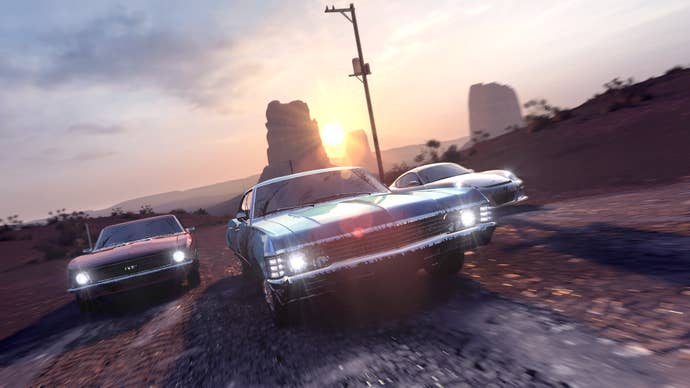
Essentially, it boils down to road trips. The Crew (2014)’s working title was “Route 66”, which is probably a much more fitting title than the one it ended up with, as it succinctly captures the game’s entire appeal. People don’t fondly recall the Fast & Furious-esque storyline, its hilariously unforgiving rubber-banding, or the fact that its driving model felt barely more sophisticated than its 360-era progenitor. What people remember about The Crew is doing big drives across the map: making that pilgrimage from Chicago to Santa Monica, or doing the heroic coast-to-coast slog from New York City to downtown LA.
These drives didn’t by any means take as long as their real-life counterparts, but they nailed the feel: the open road, the rush of awe as the various biomes of America give way to each other while scenery rushes past. From the urban sprawl of the East Coast megalopolis, to blue misty mountains, to arid deserts, to the sun-kissed fields of California. At its most inviting, The Crew was a romantic portrait of America, with roads as its canvas: the anti-GTA.
In these matters, Motorfest obviously suffers by virtue of the fact that it isn’t simulating an entire continent. That’s not to say it isn’t worthy of a few road trips: there’s a lot of tarmac to be found on O’ahu. But that specific sense of discovery that evokes Easy Rider, Thelma & Louise, or, uh, Beavis & Butthead Do America, is no longer a part of the deal. And for a sequel to The Crew, this is something that gets ever more baffling every time I think about it.
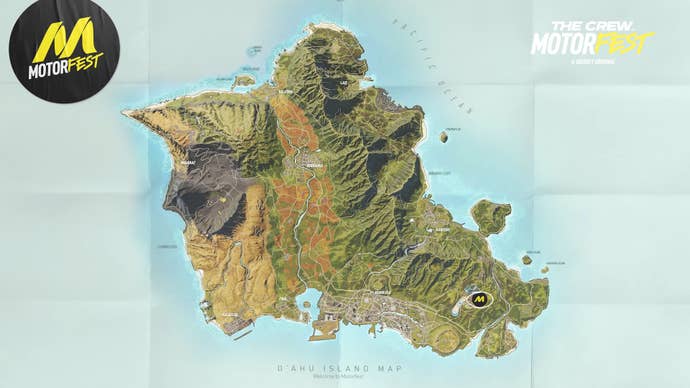
Personally, I love when a series revisits a specific map or location. It’s fun to compare Assassin’s Creed Syndicate to Watch_Dogs Legion, for example. Seeing how the micro-proportioned environment of Kamurocho develops over the years and decades is a huge part of the appeal of the Yakuza/Like a Dragon series, which just seems to be unstoppable at this point. The Crew didn’t necessarily have to abandon the continental map concept to keep going. Cities are constantly changing, after all, and other continents are available. I would love to see The Crew’s concept applied to other regions of the world than the USA.
So, in that respect, Motorfest feels like a regression. And as a direct follow-up to Test Drive Unlimited, it leaves a fair bit to be desired as well. There’s no sense of ownership of the cars, no life simulation aspect that includes visiting auto dealerships, buying apartments, and actually having cause to follow the rules of the road on occasion rather than just keeping the right trigger slammed backwards for the majority of your time in the game world. TDU’s version of O’ahu felt somewhat tangible, and what you did there didn’t feel a million miles away from the real experience of car ownership. Motorfest, in comparison, turns Hawaii into Disneyland for supercars. Or some weird afterlife for petrolheads, where you can fulfil wild dreams such as driving a DeLorean that isn’t a horrid, sluggish, rickety piece of shit.
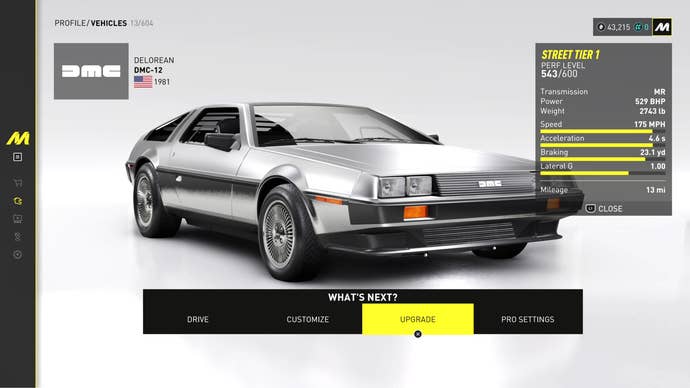
And that’s Motorfest’s new proposition in a nutshell. Not specifically the tricked out DeLoreans, but the idea that it’s a fantasy driving playground that borders on the spiritual with its wish fulfilment. On normal difficulty, the races are fairly forgiving, providing just enough challenge to not feel completely pointless but by no means ever putting a player in danger of dropping below the top three as long as they vaguely understand the concepts of breaking and accelerating. This is distinct from Forza Horizon, which does try to pay some heed to the mechanical reality of the vehicles it simulates. Single player races pose a real challenge, and career progression within its events system can often be a hard task as a result. In Motorfest, almost every car that isn’t specifically tagged as a motorsport vehicle is fitted with a nitro booster as standard, even the classic ones. It is, in fact, a key part of the second-to-second gameplay: boosting out of corners and into straights is more or less the main skill you need.
So, The Crew Motorfest is an odd beast. You can trace its lineage directly back to the original open world racer, but at this point it has discarded almost every interesting aspect of it apart from the location – think The Elder Scrolls Online’s version of Morrowind vs, er, Morrowind. It’s clearly inspired by Forza Horizon, but without Forza’s link to its more serious stablemate, there’s little incentive to ground its driving model in anything resembling reality, so we end up with a fantasy motoring game where the entirety of the automobile stock drives like a supercar.
And it’s absolutely thrilling, because it’s designed at the expense of every other aspect of driving simulation to just feel good no matter what. Are you driving a horrible steel-brushed shed on wheels from a film, but you want to overtake a Porsche 911 going at a full pelt? Done. You can do that. Want to still end up in pole position after whiffing a corner so badly that you ended up dropping down to 6th place, with only half a lap left to go? Perfectly doable, on you go son.
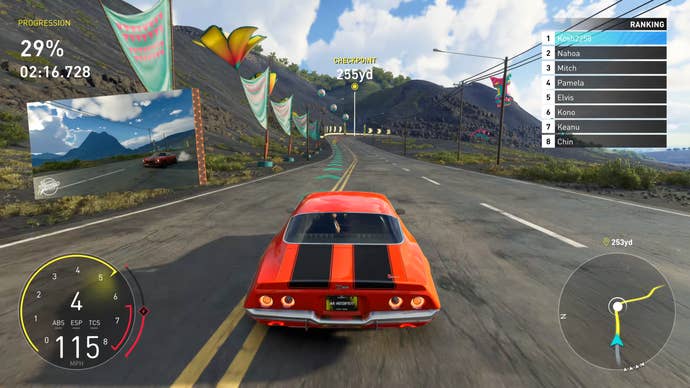
It’s patently absurd, and yet, utterly enchanting. And one of the things it does a lot better than Horizon is how it never leaves you stuck for things to do. Microsoft’s game has a big “ok so, what now?” drag factor that kicks in after the initial rush of activities. Its headline races and signature events are second to none, but in the vast gulf between those things, motivation can suffer for lack of a clear path ahead. Motorfest, in comparison, is structured around “playlists”: 15 groups of themed event races that are very clearly signposted as you progress through them. They tend to be themed around particular facets of car culture: classic cars, muscle cars, Japanese street racing. My favourite one, and I suspect the first one everyone does, is the Hawaii Scenic Tour, a magic guided spin around O’ahu’s various regions that showcases a number of different types of vehicle and also gives you a sort of Lonely Planet cliff-notes summary of local landmarks and their surroundings.
Ubisoft rightly takes a lot of pelters for its homogenous approach to game design, but one thing it does better than everyone else is digital tourism. Real world locations sampled down to their essence and hammered into video game form. The Hawaii Scenic Tour absolutely leverages this to show off Motorfest’s riches, and it is a gorgeous environment to whizz around in. Motorfest certainly has a better sense of place than any of the recent Horizons. FH4’s truncated version of the UK felt so inauthentic that it honestly felt alienating. Perhaps this is familiarity breeding contempt, but I don’t get the sense that O’ahu is similarly afflicted with this inability to distil a location down to its basic vibes in the way that Ubisoft studios have grown so masterful at doing.
In the end, everyone’s initial impression of The Crew Motorfest as being more or less Ubi’s take on Forza Horizon did more or less pan out. And it isn’t, despite sharing an island, any kind of revival of Test Drive Unlimited. It’s not even anything like The Crew. But where a lot of us were wrong, myself included, is in assuming that all this would work against it. After first impressions have gotten themselves blown off on the highway, Motorfest does enough to distinguish itself from Horizon that it can be seen as a worthy alternative. And though it’s not quite as slick, it’s much more pleasantly structured. It absolutely succeeds in matching speed with its biggest rival in the space, but also does new things with the genre that push it forward ever so slightly.
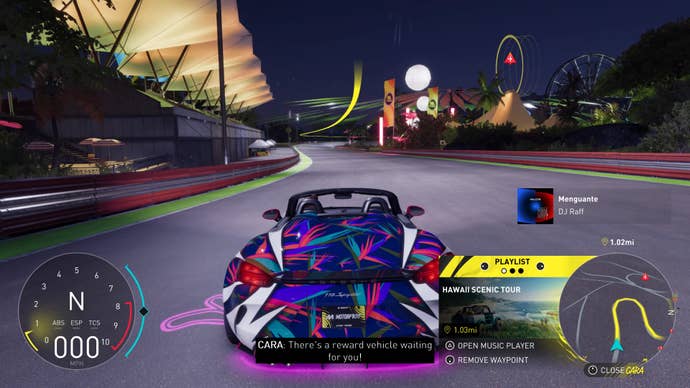
When games come along that have such a muddled identity, which isn’t a particularly rare phenomenon as this industry suffers from the two many cooks phenomenon more than any other, it’s prudent to wonder who this thing is actually for. Motorfest is a great release for Playstation users who might feel like they wouldn’t mind a bash on the latest Forza Horizon, assuming they exist. It provides something adjacent enough to the experience to satisfy those feelings without having to run out and buy an Xbox (perish the thought!). For Forza Horizon fans, it offers something mechanically distinct, that’s a lot more arcadey, but in a familiar format and a great new location. And for people who miss Test Drive Unlimited, it’s an interesting excursion back to an old haunt, albeit one that feels a little hollow, like the vaguely unsettling nostalgia of visiting a house you used to live in. Perhaps most unsettling, though, is that for people who loved The Crew or The Crew 2, assuming they exist, Motorfest is a complete departure from the things that make those games what they are.
Who is it actually for, then? People who want to drive a DeLorean up a volcano at 160mph, I guess. That’s me, I want to do that. Motorfest is incredibly daft, and overproduced, and it barely has any idea what it wants to be. But somehow, that doesn’t work against it, and the result is an extremely good time.
The Crew Motorfest is available now on everything except Nintendo Switch
[ad_2]
